Making your own shampoo bars at home is easier than you might think! Follow my detailed guide for formulating both lye based and lye-free shampoo bars—whether you give them away as gifts or regularly treat yourself to a rich lather, you’ll be inspired to make shampoo bars for the whole family.
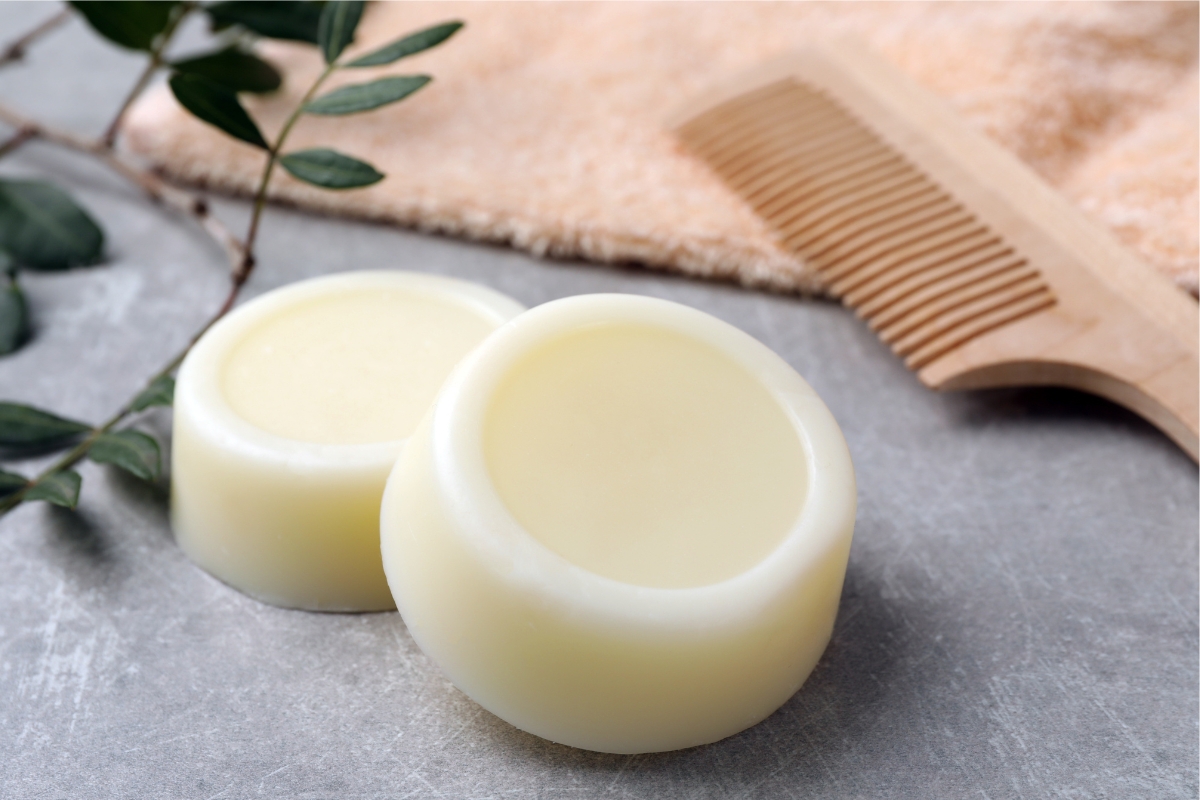
Homemade Shampoo Bars
What are Shampoo Bars?
A solid form of shampoo, shampoo bars are an alternative to traditionally packaged liquid shampoo. They are much more concentrated than liquid shampoo and can be transported in a simple tin or glass container to save on waste.
Shampoo bars are particularly handy for traveling, whether to the gym or on vacation, due to their compact and TSA-safe size.
The beauty of making your own shampoo bars lies in the recipe’s versatility: you can formulate shampoo bars to tackle all manner of hair and scalp concerns.
They can be made at home using either traditional soapmaking methods (shampoo bars with lye) or with a beginner-friendly process that makes simple melt-and-pour shampoo bars without lye.
I’m going to walk you through both methods!
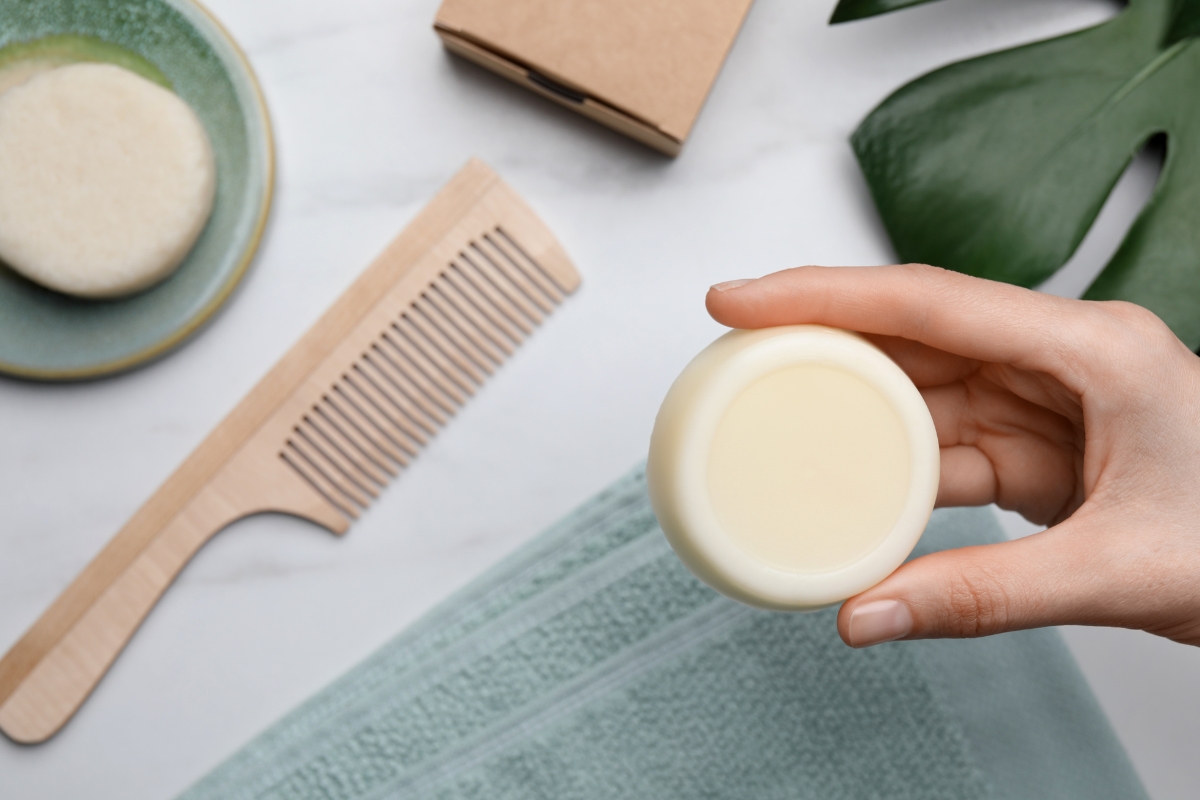
Shampoo Bars
How are Shampoo Bars Different from Regular Soap?
In all honesty, there’s a ton of overlap between shampoo bars and regular soap. They’re both made using fat and lye (in similar if not identical proportions), and they have a similar pH—which is often the so-called differentiating factor cited by home soap makers.
The main difference between shampoo bars and regular soap is the choice of oils, which enhance lather and help to nourish your hair while cleansing. Shampoo bars usually have quite a bit of extra fats to ensure that they’re not drying, and they’ll start the conditioning process while you wash.
If you opt to add essential oils or any other extra materials to your shampoo bar, you might choose ingredients specifically recommended for haircare (rosemary essential oil, for hair growth, springs to mind).
Ingredients for Shampoo Bars
In their most basic form, shampoo bars are made with two ingredients: fat and lye. Additional ingredients, such as essential oils, can also be included if you like scented shampoo bars.
I’m going to walk you through how to make shampoo bars at home, including traditional from scratch shampoo bars with lye and beginner-friendly melt-and-pour shampoo bars without lye.
Lye
I often hear about people who are reluctant to make soap or shampoo bars at home because of the inclusion of lye (and I get it, lye=corrosive=possibility of home accidents).
Truthfully, like many other chemicals used in skin and hair care products, lye simply demands a basic level of respect: don’t put it in your mouth, never combine it with aluminum, and use it in a well-ventilated space.
You should also avoid contact with the skin—even clothed areas. If contact occurs, brush lye away using a cloth or a plastic utensil and hold the afflicted area under cold running water. Always wear gloves when working with lye.
Lye is also referred to as caustic soda. It is specifically used to make solid shampoo bars and soap—soap that is made without lye is considered a detergent or other type of cleanser.
Shampoo bars are made with a combination of lye and fats/oils—the lye is responsible for transforming the mixture into a solid, latherable shampoo bar. If the lye was excluded, the fats would remain in their liquid, unblended state. This transformation is called saponification.
I purchase lye (sodium hydroxide) in a plastic container online, but you should also be able to find it at any craft store that sells soap-making supplies.
Fats
- Castor oil: yields ultra-foamy shampoo bar; stimulates hair follicles; good for thinning hair and for hair with split ends.
- Olive oil: high in antioxidants; has anti-bacterial and anti-inflammatory properties; good as an all-purpose fat and for dull hair.
- Avocado oil: rich in vitamin E and antioxidants; excellent choice for hair that is dry or damaged.
- Cocoa butter: super moisturizing; suitable for those with dull hair or coarse hair; helps with split ends.
- Mango butter: buttery tropical scent; source of vitamins A and E; helps relieve itchy scalp associated with dandruff.
- Tallow: made from purified animal lard; ultra moisturizing; source of vitamins A, D, E, and K; yields a long-lasting bar; great choice for dry and frizzy hair.
- Shea butter: source of antioxidants and vitamins A and E; good for dry and coarse hair.
- Coconut oil: antibacterial; promotes hair growth; an excellent option for those with dry or thinning hair.
Essential oils
Essential oils aren’t necessary ingredients for shampoo bars, but I think they can elevate a basic bar into something truly special. Some of my favorite essential oils to add include rosemary, peppermint, rose, geranium, eucalyptus, and cedar.
Melt and pour soap bases (making shampoo bars without lye)
All melt and pour soaps contain glycerin as a base, but other ingredients—typically in the form of oils and butters—can be added to formulas in order to change the medicinal and physical properties of your finished shampoo bar.
Some popular melt-and-pour options feature the following ingredients:
- Coconut milk: a melt-and-pour soap base that contains no superfast (which means it won’t leave a residue); best cleaning base with antimicrobial properties; suitable for combination or oily scalp types.
- Goat’s milk: a milky, soft white soap that’s ultra-nourishing; suitable for dry and and sensitive scalp types.
- Honey: beneficial for those with dry or acne-prone skin; anti-microbial and antioxidant properties; doesn’t strip hair of natural oils.
- Shea butter: perfect for those who have a dry, itchy scalp; produces a creamy shampoo bar; doesn’t lather as much as other melt and pour options.
- Glycerin: best option if you want a clear shampoo bar; all melt-and-pour soap bases contain glycerine, but this type has no other additives; a great choice if you plan on adding color or flowers/plant material.
- Cocoa butter: rich in vitamin E; has a subtle, chocolate-y aroma; known for being super moisturizing and soothing.
- Aloe vera: soothes and calms the scalp; produces a silky lather; moisturizing and anti-inflammatory; another good option if you plan on adding color to your bars.
- Hemp: super moisturizing and revitalizing; rich, creamy lather; is anti-inflammatory and rich in omega fatty acids.
- Charcoal: good for oily scalps; striking black color (can stain bath tubs and sinks); anti-inflammatory properties.
- Oatmeal: yields a shampoo bar with a soft, natural white base color (although it also makes a good neutral base if you want to add color); exfoliating and antibacterial properties; good for mature, dry, and sensitive scalp types.
- Olive oil: has impressive anti-inflammatory, anti-itch, and moisturizing properties; produces a luxurious, thick lather; holds scent well.
- Castille: similar benefits to olive oil soap; does an excellent job of cleaning the hair and scalp without stripping away natural oils.
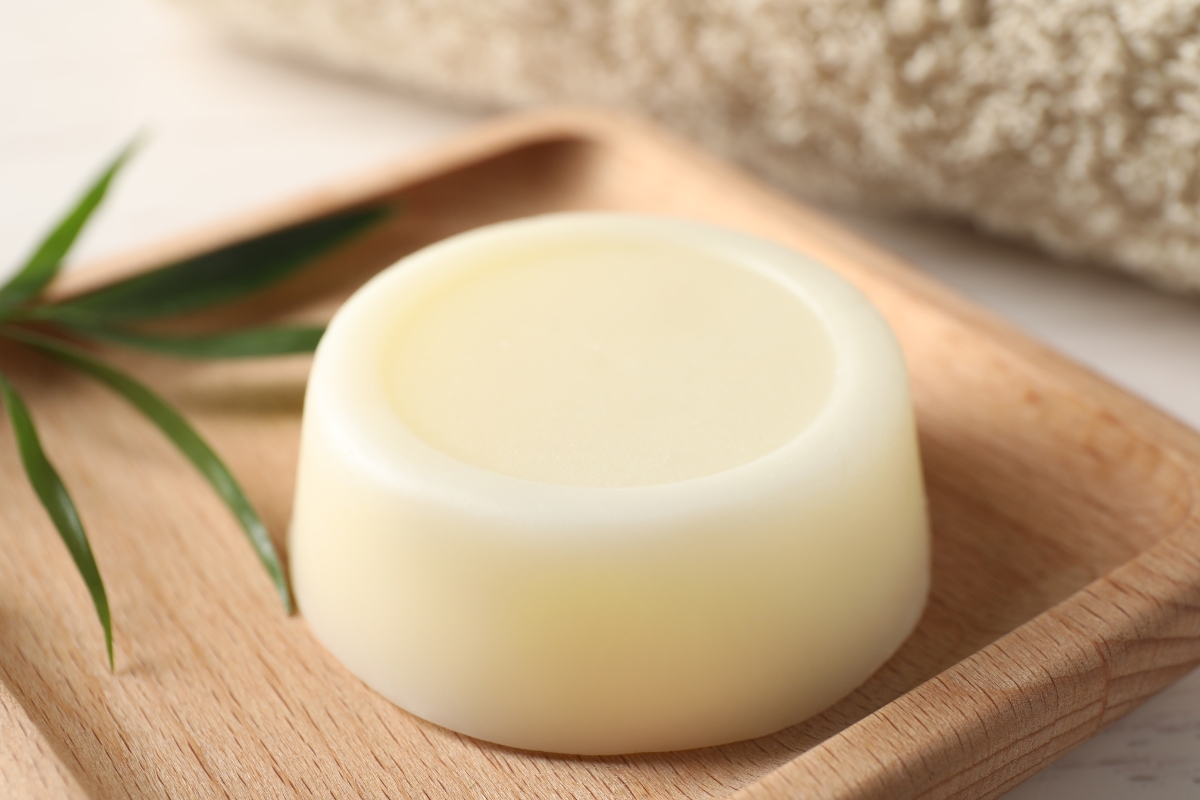
Shampoo Bars
Equipment for Making Shampoo Bars
Making your own shampoo bars requires only a few fairly basic pieces of equipment, most if not all of which you likely already own:
- Kitchen scale: In my opinion, a good kitchen scale is the most important piece of equipment for making shampoo bars. Your measurements will be far more accurate, yielding better and more quality results with your finished shampoo bars.
- Heat-proof mixing bowls (non-aluminum)
- Kitchen thermometer
- Hand blender
- Silicone spatula/spoon
- Shampoo bar molds
How to Make Shampoo Bars
This recipe calls for a combination of olive, coconut, and sweet almond oils. Feel free to substitute your choice of fats, but make sure you recalculate the amount of lye needed for the new fats before making your bars.
You can find out more about lye calculators—and why they’re so important—here.
To make this all-purpose shampoo bar you’ll need:
- 5 ounces of olive oil
- 5 ounces of liquid coconut oil
- 5 ounces of sweet almond oil
- 2 ounces of lye
- 6 ounces of cool water
- 25 drops of essential oil (optional)
Depending on the size of your shampoo bar molds, this recipe will make anywhere between 4 to 6 bars.
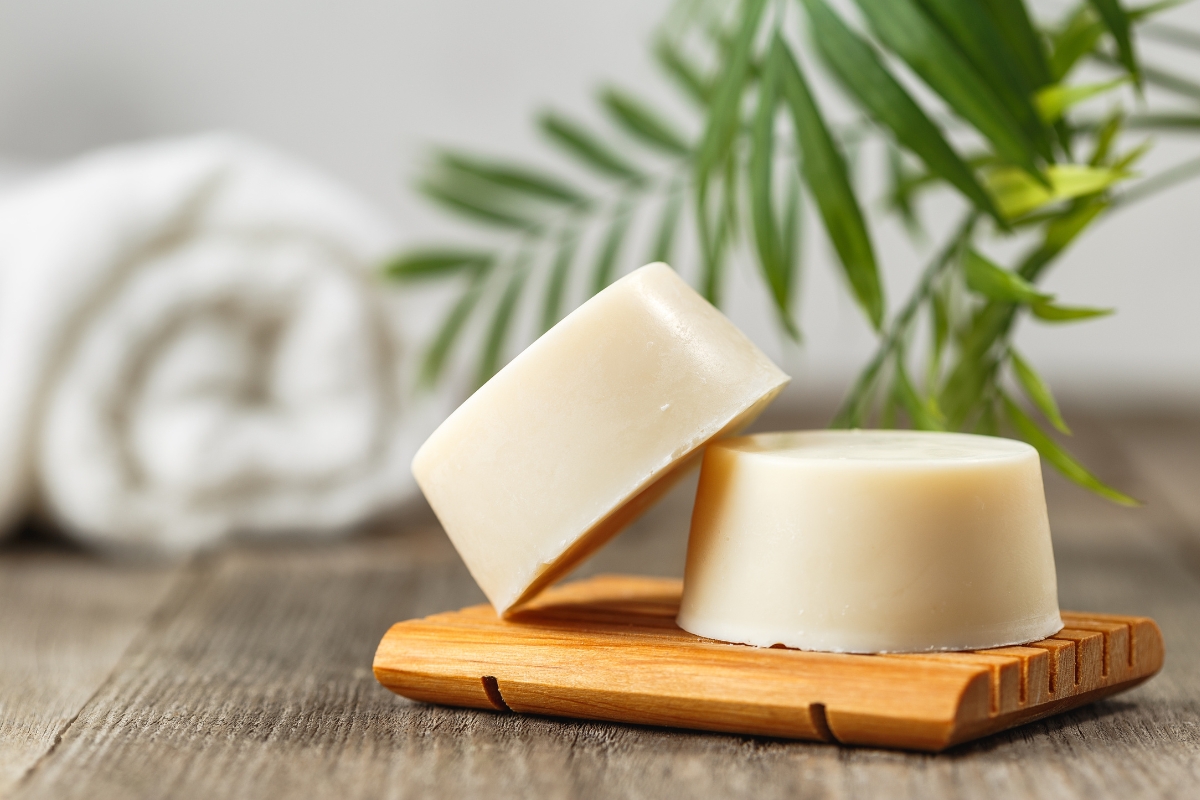
Shampoo Bars
*A few safety notes before you begin: Always make shampoo bars in a well-ventilated room. Always wear gloves when handling lye or any formulations containing lye. Pay close attention to the order in which ingredients are combined and follow all instructions closely.
Add each of the oils to a large glass or stainless steel boil (avoid aluminum bowls). If you have a bowl with a spout even better, it will come in handy later in the process.
Take a large, heat-proof second container and pour in the cool water. Pour in the lye slowly and in a steady stream, stirring the two together constantly. Be mindful of fumes.
Let the lye and water mixture cool down to 125°F/50°C.
Stir the oil into the lye and water. Use a hand blender to blend the ingredients until the mixture “traces” along the bottom of the bowl (it should resemble thick pudding).
For even more moisturizing properties, stir in an extra tablespoon of oil along with your choice of essential oils, if using.
At the stage, the shampoo is ready to be poured into the soap molds you’ve chosen. Give them at least 24 hours in the mold before you pop them out. These shampoo bars will need to cure for 4 to 6 weeks before they’re ready to be used.

Shampoo Bars
How to Make Shampoo Bars Without Lye
This recipe makes enough shampoo for four standard-sized bars.
You’ll need these ingredients to make lye-free shampoo bars:
- 1 pound of melt and pour soap base
- 2 teaspoons of your favorite nourishing hair oil
- 1 teaspoon of cocoa or shea butter
- 25 drops of essential oil (optional)
And a handful of basic shampoo bar-making equipment:
- soap molds
- double boiler (or a metal or heat-proof glass mixing boil and a small pot to set it in)
- silicone spoon or spatula (makes cleanup significantly easier)
Add solid melt and pour soap base to the double boiler (chop or cube for even, faster melting). Bring the water to a simmer and melt the soap base until uniformly liquid.
Remove melted soap base from the heat. Carefully and thoroughly stir in oil, butter, and essential oils (if using).
Pour the soap mixture into shampoo bar molds—give the sides a gentle tap to settle air bubbles. Let the shampoo bars harden over the next several hours.
When the shampoo bars are solid, pop them out of the mold and use as needed. Keep bars as dry as possible when not in use.
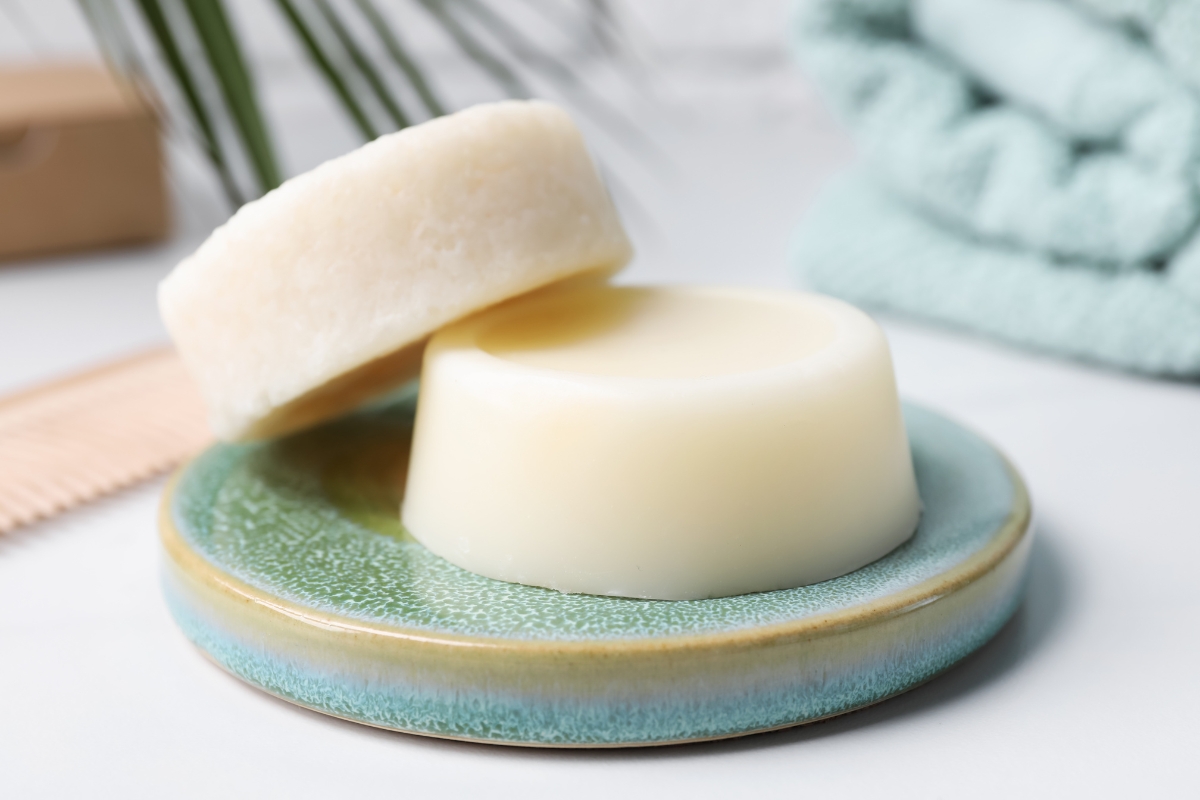
Shampoo Bars
How to Use Shampoo Bars
Using a shampoo bar to cleanse your hair and scalp is fairly similar to using traditional liquid shampoo—there’s just a bit more elbow grease involved.
Make sure hair is completely soaked, this will encourage a proper lather as you scrub. Gently rub the shampoo bar onto your wet hair, starting with only a few swipes (you can always adjust as needed).
At this point the bar should be foaming into a gentle lather. Focus on your roots end let the shampoo redistribute through the rest of your hair.
When your hair and scalp feel clean, rinse away the remaining shampoo using room temperature or even cool water.
Follow with a simple apple cider vinegar rinse or whichever natural hair conditioner you prefer using.
How to Make Shampoo Bars
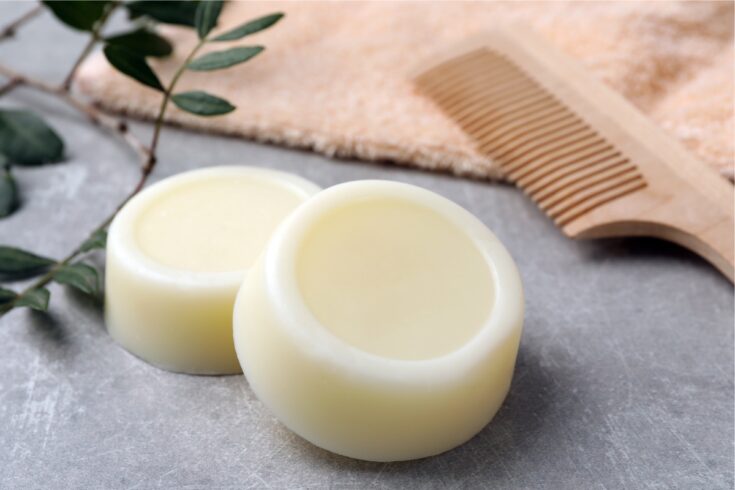
A basic recipe for shampoo bars that is suitable for all hair types (plus, instructions for making shampoo bars without lye!).
Materials
- 5 ounces olive oil
- 5 ounces liquid coconut oil
- 5 ounces sweet almond oil
- 2 ounces lye
- 6 ounces cool water
- 25 drops essential oil (optional)
Instructions
- Combine all of the oils in a large, heat proof container.
- Add the cool water to a second large, heatproof container.
- Carefully pour the lye into the cool water, stirring the entire time.
- Let the lye and water mixture cool down to 125°F/50°C.
- Carefully stir the lye and water mixture. Then use a hand blender to blend until the mixture takes on the texture of pudding. This is called tracing.
- Add an extra tablespoon of moisturizing oil and 25 drops of essential oils if desired.
- Decant the liquid soap/shampoo into the molds. Allow the soap to harden for 24 hours in the mold.
- Remove the shampoo bars from the mold and let them cure for 4 to 6 weeks before using them.
- Store cured shampoo bars in a dry environment away from moisture and heat.
Notes
To make lye-free shampoo bars, you'll need:
- 1 lb. melt and pour soap base
- 2 tsp. oil
- 1 tsp. cocoa or shea butter
- 25 drops of essential oil (optional)
1. Add melt and pour soap base to the double boiler (chop or cube for even melting). Bring the water to a simmer and melt the soap base until liquid.
2. Remove melted soap base from the heat. Stir in oil, butter, and essential oils (if using).
3. Pour the soap mixture into shampoo bar molds. Let the shampoo bars harden over the next several hours.
4. When the shampoo bars are solid, pop them out of the mold and use as needed. Keep bars as dry as possible when not in use.
Natural Body Care Products
Looking for more ways to care for your body naturally?
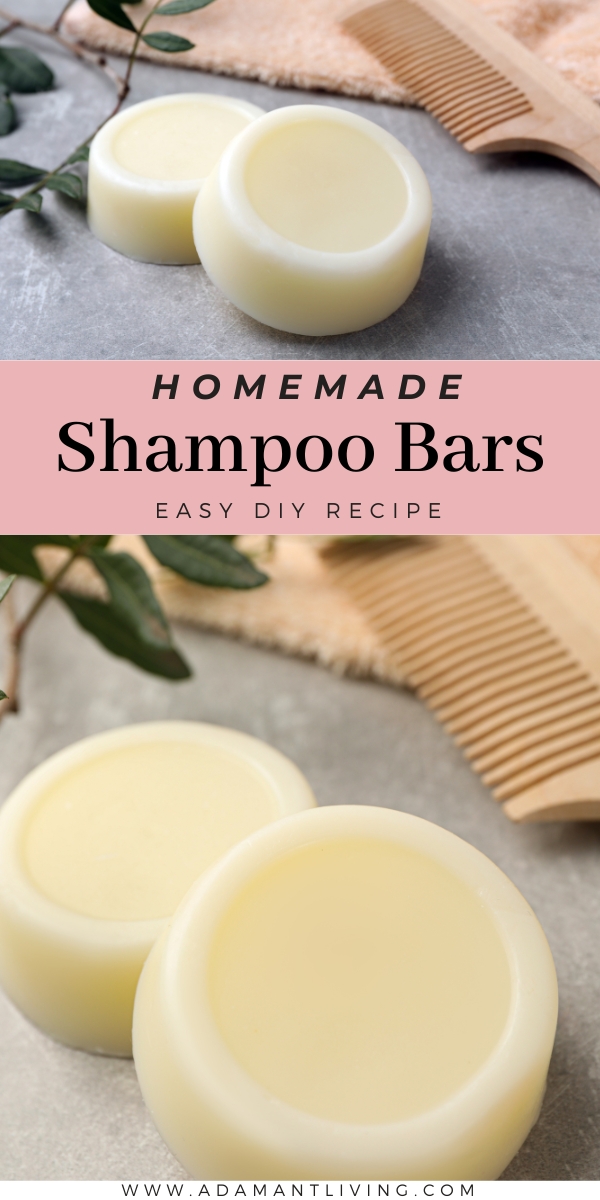
Awesome website with easy instructions on shampoo making! Thanks for posting and making it so easy to read, follow and make shampoo bars!